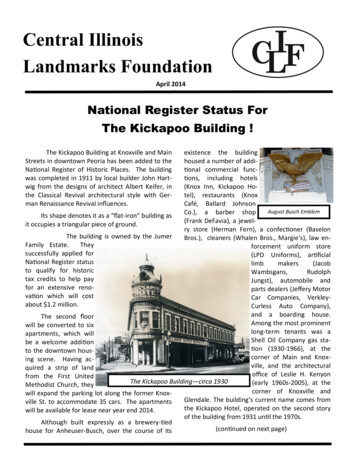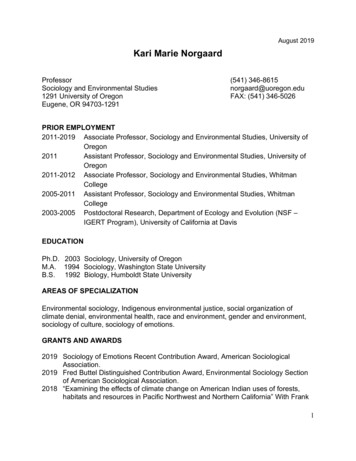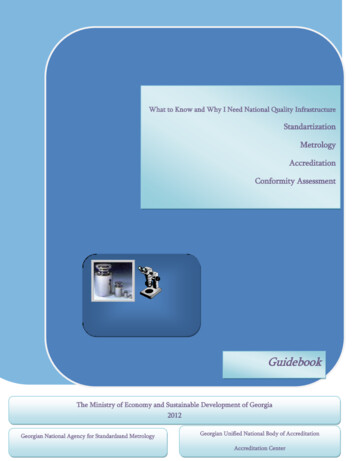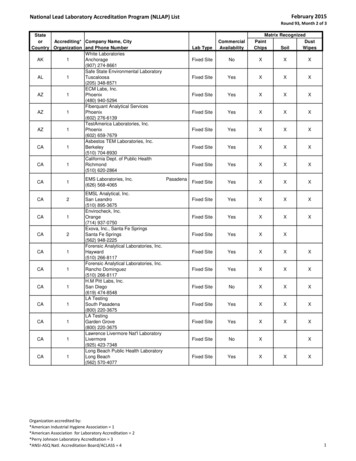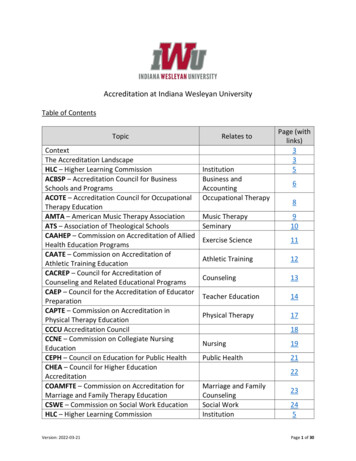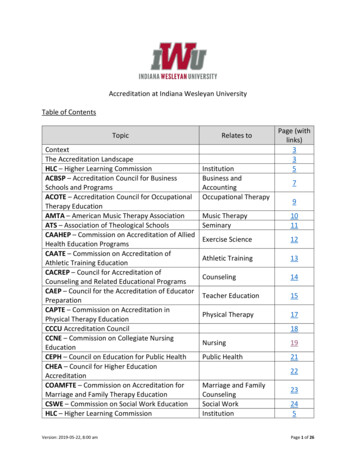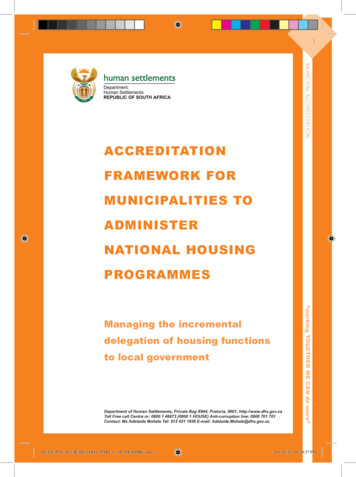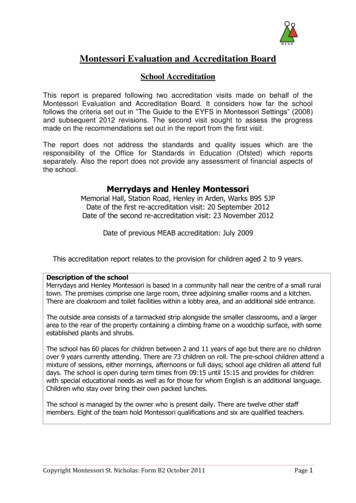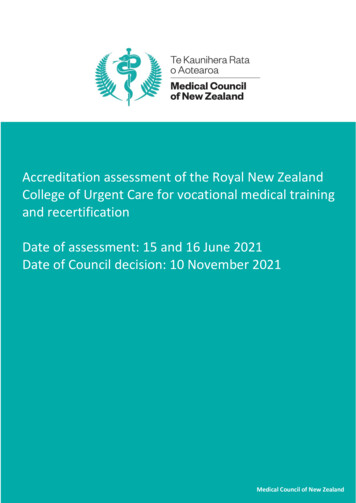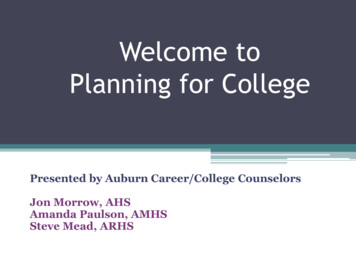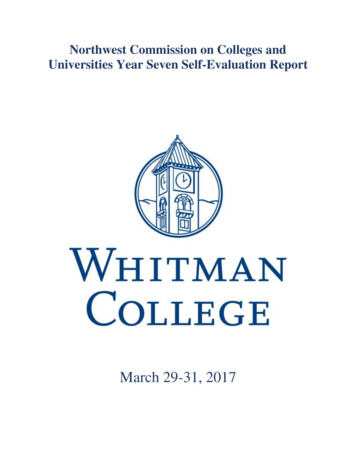
Transcription
Northwest Commission on Colleges andUniversities Year Seven Self-Evaluation ReportMarch 29-31, 2017
Year Seven Self-EvaluationTable of ContentsInstitutional Overview ------------------------------------ 1Basic Institutional Data Form -------------------------- 3Preface ---- 16Brief Update on Institutional Changes Since the Last Report . 16Response to Recommendations/Issues by the Commission . 17Standard One – Mission, Core Themes and Expectations ---------------------------------------- 18Executive Summary of Eligibility Requirements 2 and 3 . 182. Authority . 183. Mission and Core Themes . 181.A – Mission . 18Interpretation of Fulfillment of Whitman College’s Mission . 19Articulation of Acceptable Threshold or Extent of Whitman College MissionFulfillment . 201.B – Core Themes . 21The Whitman College Core Themes . 21Core Theme I: Academic Excellence . 21Core Theme II: Student Engagement, Personal Development, and Leadership . 28Core Theme III: Collaboration and Community . 32Standard Two – Resources and ------------------- 37Executive Summary of Eligibility Requirements 4-21 . 374. Operational Focus and Independence . 375. Non-discrimination. 376. Institutional Integrity . 377. Governing Board . 388. Chief Executive Officer . 389. Administration . 3810. Faculty . 3911. Educational Program . 3912. General Education and Related Instruction . 3913. Library and Information Resources . 4014. Physical and Technological Infrastructure . 4015. Academic Freedom. 4016. Admissions . 4017. Public Information . 4118. Financial Resources . 41
19. Financial Accountability . 4120. Disclosure . 4121. Relationship with the Accreditation Commission . 422.A – Governance . 432.A – Governing Board . 462.A – Leadership and Management . 492.A – Policies and Procedures . 51Academics . 51Students . 52Human Resources . 56Institutional Integrity . 57Academic Freedom . 63Finance . 642.B – Human Resources . 65Personnel Reviews . 712.C – Education Resources. 74Undergraduate Programs . 81Graduate Programs . 85Continuing Education and Non-Credit Programs . 862.D – Student Support Resources . 86Student Engagement Center . 87Academic Resource Center . 89Welty Health and Wellness Center . 90Intercultural Center. 90Fellowships and Grants . 91Off‐Campus Studies . 92The Outdoor Program . 93Baker Ferguson Fitness Center and Louise and Paul Harvey Pool . 93Museums and Galleries . 94Food Service . 107Student Housing . 108Bookstore. 1102.E – Library and Information Resources . 1142.F – Financial Resources . 1192.G – Physical and Technological Infrastructure . 122Physical Infrastructure . 122Technological Infrastructure. 124Standard Three – Planning and Implementation ------------------------------------------------- 128Core Theme Planning, Assessment, and Improvement. 128Executive Summary of Eligibility Requirements 22 and 23 . 128
22. Student Achievement . 12823. Institutional Effectiveness . 1283.A – Institutional Planning . 1293.B – Core Theme Planning . 133Standard Four – Effectiveness and Improvement ------------------------------------------------ 1374.A – Assessment . 1374.B – Improvement . 141Standard Five – Mission Fulfillment, Adaptation and Sustainability ----------------------- 144Executive Summary of Eligibility Requirement 24 . 14424. Scale and Sustainability. 1445.A – Mission Fulfillment . 1445.B – Adaptation and Sustainability. 145Conclusion ------------------------------------------------ 148Appendices ----------------------------------------------- 153Appendix A – Campus Office(s) Responsible for Indicators and Benchmark Achievementa 153
Institutional OverviewWhitman College, a private, independent, non-sectarian, residential, liberal arts college, has been incontinuous operation in Walla Walla, Washington, since 1882 and was chartered in 1883. The Collegeis highly selective, with a 43% admittance rate for 2015. The consistently cited top reason forattending Whitman College, as reflected in first-year students’ responses to the CooperativeInstitutional Research Program (CIRP) survey in 2011-2015, is “Good Academic Reputation.”Students admitted for Fall 2015 had median SAT scores of 660 in Critical Reading, 650 in Math, and650 in Writing, and a median ACT score of 30. Whitman students currently have a first year retentionrate of 93%, a second year retention rate of nearly 91%, and a five-year graduation rate ofapproximately 87%. Between 36-45% of the students participated in an off-campus study programduring their time at the College during the years 2011-2016. In 2015, Whitman College was named inthe Chronicle of Higher Education as a “top producer” of Fulbright awards for students (there wereseven in 2015). One Whitman student was named a Goldwater Scholar and one received a Beineckescholarship. The College library, one computer lab, and health care facilities are open 24 hours a day,seven days a week. The College enrolled 1,430 full-time and 40 part-time students in the Fall 2015semester. These students hailed from 43 U.S. states and territories and 25 other nations. More than25% were minority or international students. The average class size was 16.3 in Fall 2015 and 16.7 inFall 2014, and the College maintained a student/faculty ratio of 8.2/1 as of Fall 2015. More than twothirds of students live on campus. Whitman College provides financial aid — some combination ofscholarships, grants, loans and/or employment — to roughly 80% of students attending the College inany given year. In 2015-16, the average need-based aid package was 34,824.In 2015-2016 there were 173 full-time faculty members, with a total head count of 238. Students maychoose from among 47 majors and 32 minors, or they may create an Individually Planned Major(IPM). Whitman has developed more than 20 innovative teaching and learning programs, includingSemester in the West, History and Ethno-botany of the Silk Roads, the Global Studies Initiative, theCross-Disciplinary Learning and Teaching Initiative, and Crossroads off-campus study courses, toname a few. These programs bolster cross-disciplinary learning and curricula that encourage studentsand faculty to cultivate connections between different provinces of inquiry. Faculty members areexperts in their fields and are devoted to student learning. They routinely collaborate with students onscholarly endeavors at levels more commonly associated with graduate students. Whitman is a recentrecipient of grants from such prestigious organizations as the Mellon Foundation, National Institutesof Health, the Teagle Foundation, and the National Science Foundation. In 2013 the NSF ranked thenation’s colleges for producing graduates who earn Ph.D. degrees in science and engineering on a percapita basis. Whitman ranked 20th among national liberal arts colleges, up from 27th in 2008, and36th overall, up from 47th. Once students leave Whitman, many remain connected and committed to theCollege's mission. More than 40 percent of alumni regularly give to or volunteer for the College.The 2010-2011 academic year served as a time for review of the College’s mission and thedevelopment of core themes. These encompass Whitman’s mission as a four-year liberal arts collegededicated to rigorous teaching, learning, and scholarship. Between 2011 and 2013 the College updatedthe core themes and gathered information on the resources and capacities that allow for the fulfillmentof the mission. The mission statement was approved in 1995 and is referenced in all College planningdocuments, and the core theme development process was used to examine whether it still accuratelycaptures the goals and operations of the College. The conversations and deliberations surroundingcore theme development and the synthesizing of information pertaining to the College’s resources andcapacity provided opportunities to closely examine the College’s publication and planning documentsand to seek congruence between the mission, resources, planning processes, and existing practices.1 Page
The Year Seven report consists of updates to the Year One (Mission and Core Themes) and Year Three(Resources and Capacity) reports, as well as an evaluation of the planning, implementation, effectiveness,improvement, mission fulfillment and sustainability standards (Standards Three, Four and Five) as theypertain to Whitman College. For the Year One revisions, each office responsible for submitting data forthe indicators was consulted to decide on appropriate benchmarks and to revise any indicators that wereoutdated. The updates to the Year Three standards were gathered from appropriate offices andincorporated into the working document. Similarly, the Year Seven report was crafted based onconsultations with various campus offices and with College leadership.It is important to note that Whitman College has a new President as of 2015, a new Provost and Dean ofthe Faculty as of 2016, a new Vice President for Diversity and Inclusion as of 2015, and a new VicePresident for Communications and Public Relations as of 2016. By 2017, the College will also have anew Vice President for Student Affairs and Dean of Students. Thus, five out of nine members of thePresident’s Cabinet will have been at the College less than two years. During this period of transition inleadership, every effort has been made to ensure that strategic planning for the future of the College willbe comprehensive, effective, and visionary. To that end, the Strategic Planning Committee has beenconstituted with broad campus representation, including members from the Governing Boards, faculty,staff, and students. Although strategic planning is just beginning, President Kathleen Murray hasidentified the following five priorities for the next three years, with the understanding that they will berevisited annually: Build and support a more inclusive community Enhance student learning through faculty and staff collaboration Organize for strategic planning Continue facilities planning to enhance learning and community Build the entering classes of 2016-2018For 2016-2017 specifically, the President’s Cabinet has set the following goals: Continue to build and support a more inclusive and diverse community. Move forward with the Living at Whitman initiative to strengthen our undergraduate residentialexperience. Make Whitman an increasingly safe campus by bolstering policies and procedures, communityeducation, risk management, and emergency preparedness. Support the College’s strategic planning process to maximize transparency and engagement withthe Whitman community. Steward the college’s budget in a manner that is sustainable in this period of change and preparesthe college to achieve the imperatives set forth in the strategic plan. Ensure that Whitman’s internal and external communications are consistent and advanceWhitman’s strategic priorities.As these priorities are addressed, reassessed, and folded into strategic planning, the Strategic PlanningCommittee will deliberate with the current mission and core themes in mind. Whitman College has astrong and proud tradition of providing a liberal arts education that is among the best in the country.While maintaining that foundation, Whitman strives to stay abreast of changing technologies, globalissues and innovation in teaching and research. Thus, Whitman College embarks on strategic planningwith perfect timing as it respectfully submits its Year Seven Self-Evaluation. The College is perfectlypoised, under new leadership, to evaluate its mission and core themes in preparation for cycling back toYear One and Standard One – Mission and Core Themes, in the coming year.2 Page
Northwest Commission On Colleges and UniversitiesBasic Institutional Data FormInformation and data provided in the institutional self-evaluation are usually for the academic and fiscalyear preceding the year of the evaluation committee visit. The purpose of this form is to provideCommissioners and evaluators with current data for the year of the visit. After the self-evaluation reporthas been finalized, complete this form to ensure the information is current for the time of the evaluationcommittee visit. Please provide a completed copy of this form with each copy of the self-evaluation reportsent to the Commission office and to each evaluator.To enable consistency of reporting, please refer to the glossary in the 2003 Accreditation Handbook fordefinitions of terms.Institution: Whitman CollegeAddress: 345 Boyer Ave.City, State, ZIP: Walla Walla, WA 99362Degree Levels rIf part of a multi-institution system, name of system:Type of tutional control:PublicCityCountyFor Profit)Institutional rivate/Independent (Continuous TermOtherNon-profitOther (specify)Specialized/Programmatic accreditation: List program or school, degree level(s) and date of lastaccreditation by an agency recognized by the United States Department of Education. (Add additionalpages if necessary.)Program or SchoolChemistryDegree Level(s)BaccalaureateRecognized AgencyAmerican Chemical SocietyDate2015Revised February 20113 Page
Full-Time Equivalent (FTE) Enrollment (Formula used to compute FTE: 12 credits 1 FTE, lessthan12 Credits divided by 15)Official Fall 2015 (most recent year) FTE Student EnrollmentsCurrent YearOne Year PriorClassificationDates: 2015-2016Dates: onalUnclassified9.26.9Total all levels1445.61478.3Two Years PriorDates: 2013-141513.661519.6Full-Time Unduplicated Headcount Enrollment. (Count students enrolled in credit courses only.)Official Fall 2015 (most recent year) Student Headcount EnrollmentsCurrent YearOne Year PriorTwo Years PriorClassificationDates: 2015-2016Dates: 2014-2015Dates: onalUnclassified272016Total all levels147014981541Numbers of Full-Time and Part-Time Instructional and Research Faculty & Staff and Numbers ofFull-Time (only) Instructional and Research Faculty & Staff by Highest Degree Earned. Includeonly professional personnel who are primarily assigned to instruction or research.RankProfessorAssociate ProfessorAssistant ProfessorInstructorLecturer andTeaching AssistantResearch Staff andResearch AssistantUndesignated RankTotal NumberFullPartTime Time334580711723291211Number of Full Time (only) Faculty and Staff by Highest Degree EarnedLess thanAssociate Associate Bachelor Masters Specialist Doctorate2314542105911171Mean Salaries and Mean Years of Service of Full-Time Instructional and Research Faculty andStaff. Include only full-time personnel with professional status who are primarily assigned to instructionor research.RankProfessorAssociate ProfessorAssistant ProfessorMean Salary 118,817 92,074 63,825Mean Years of Service23.013.43.84 P age
InstructorLecturer and Teaching AssistantResearch Staff and Research AssistantUndesignated Rank 56,500 59,5901.014.7Financial Information. Complete each item in the report using zero where there is nothing to report.Enter figures to the nearest dollar. Auxiliary and service enterprises of the institution (housing, foodservice, book stores, athletics, etc.) should be included. The institution’s audit materials should be anexcellent reference for completing the report.Fiscal year of the institution:Reporting of income:Reporting of expenses:June 30Accrual BasisAccrual BasisYesYesAccrual BasisAccrual BasisBALANCE SHEET DATAASSETSCurrent FundsUnrestrictedCashInvestmentsAccounts receivable grossLess allowance for bad debtsInventoriesPrepaid expenses and deferred chargesOther (Deferred compensation)Due fromTotal UnrestrictedRestrictedCashInvestmentsOther (Accounts receivable)Other (Contributions receivable)Due fromTotal RestrictedTotal Current FundsEndowment and Similar FundsCashInvestmentsOther (Contributions receivable)Other (Real estate (net))Other (Prepaid and Student loans)One Year Priorto LastCompleted FYDates: 2015Two Years Priorto LastCompleted FYDates: 2014Two Years Priorto LastCompleted FYDates: ,111458,946,80414,839,65818,079,37632,8005 P age
Due fromTotal Endowment and Similar FundsPlant FundUnexpendedCashInvestmentsOther (identify)Total unexpendedInvestment in PlantLandLand improvementsBuildingsEquipmentLibrary resourcesOther (Collections and artwork)Total investments in plantDue fromOther plant funds (identify)Total Plant FundsOther Assets (Student loans)Other Assets (Student loan cash)Total Other AssetsTotal AssetsLiabilitiesCurrent FundsUnrestrictedAccounts payableAccrued liabilitiesStudents’ depositsDeferred creditsOther liabilities (Deferredcompensation)Other liabilities (Retiree medical)Other liabilities (Medical insurancetermination)Other liabilities (Salary 87,754,742One Year Priorto LastCompleted FYDates: 2015Two Years Priorto LastCompleted FYDates: 2014Two Years Priorto LastCompleted FYDates: ,332,729958,398918,182879,0560991,0001,554,7346 P age
Due toFund balanceTotal UnrestrictedRestrictedAccounts payableOther (identify)Due toFund balanceTotal 4Total Current wment and Similar FundsOther (Accounts payable)Other (Mortgage payable)Other (Beneficiary payable)RestrictedQuasi-endowedDue toTotal Endowment and Similar FundsPlant FundUnexpendedAccounts payableNotes payableBonds payableOther liabilities (Identify)Due toFund balanceTotal unexpendedInvestment in PlantNotes payableBonds payableMortgage payableOther liabilities (Swaps)Other liabilities (Asset retirementobligation)Due toTotal Investments in Plant FundOther Liabilities (Governmentprogram and other payable)Other Liabilities (Student loans due to)7 P age
Total Other LiabilitiesTotal LiabilitiesOther fund balance (Student 332179,4213,691,206131,509,020152,389Fund Balance632,155,753624,966,515556,245,722CURRENT FUNDS, REVENUES, EXPENDITURES, AND OTHER CHANGESOne Year Prior Two Years Priorto Lastto Last CompletedRevenuesCompleted FYFYDates: 2015Dates: 2014Tuition and fees68,662,90668,500,539Federal appropriations605,086679,824State appropriations60,75149,023Local appropriations00Grants and contracts191,25659,491Endowment income20,037,68418,529,998Auxiliary enterprises9,697,4069,641,540Other (Contributions)2,893,5305,205,742Other (Investment return)360,5031,471,864Other (Fees and departmental revenues)1,372,1071,221,644Expenditure & Mandatory TransfersTwo Years Priorto LastCompleted FYDates: ,8174,133,2621,326,4251,462,568Educational and GeneralInstructionResearchPublic servicesAcademic supportStudent servicesInstitutional supportOperation and maintenance of plantScholarships and fellowshipsOther (Reserves)Mandatory transfers for:Principal and interestRenewal and replacementsLoan fund matching grantsOther (reserves)Total Educational and GeneralAuxiliary EnterprisesExpendituresMandatory transfers ,766,5118 P age
Principal and interestRenewals and replacementsOther (Reserves)Total Auxiliary EnterprisesTotal Expenditure & MandatoryTransfersExcess [deficiency of revenues overexpenditures and mandatory transfers(net change in fund 81798,628,239(510,403)5,371,542(782,571)One Year Priorto LastCompleted FYDates: 201555,880,5610Two Years Priorto Last CompletedFYDates: 201457,009,4690Two Years Priorto LastCompleted FYDates: 201358,093,1700INSTITUTIONAL INDEBTEDNESSTotal Debt to Outside PartiesFor Capital OutlayFor OperationsDomestic Off-Campus Degree Programs and Academic Credit Sites: Report information for offcampus sites within the United States where degree programs and academic coursework is offered. (Addadditional pages if necessary.)Degree Programs – list the names of degree programs that can be completed at the site.Academic Credit Courses – report the total number of academic credit courses offered at the site.Student Headcount – report the total number (unduplicated headcount) of students currently enrolled inprograms at the site.Faculty Headcount – report the total number (unduplicated headcount) of faculty (full-time and parttime) teaching at the site.PROGRAMS AND ACADEMIC CREDIT OFFERED AT OFF-CAMPUS SITES WITHIN THE UNITED STATESLocation of SiteAcademicNameDegreeCreditStudentFacultyCity, State, ZIPProgramsCoursesHeadcount HeadcountSEA Semester, Woods Hole, MAn/an/a60The Philadelphia Center, Philadelphia, PAn/an/a20AU Washington Sem
College's mission. More than 40 percent of alumni regularly give to or volunteer for the College. The 2010-2011 academic year served as a time for review of the College's mission and the development of core themes. These encompass Whitman's mission as a four-year liberal arts college dedicated to rigorous teaching, learning, and scholarship.
